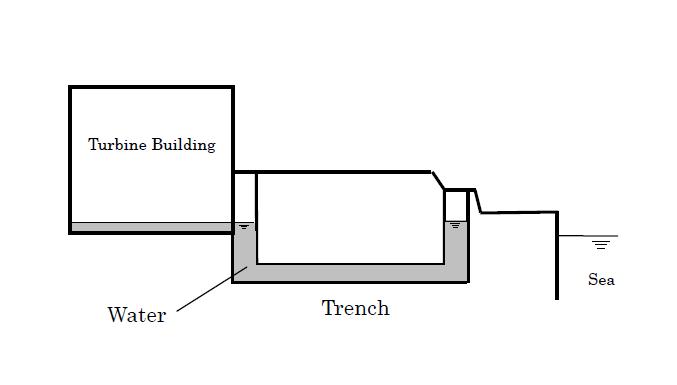Fukushima workers start emptying trench water
13 April 2011
Workers at the Fukushima Daiichi nuclear power plant have begun pumping contaminated water from the flooded cabling trench at unit 2. Work to empty water from the trenches at units 1 and 3 will follow. Meanwhile, minute quantities of strontium have been detected near the stricken plant.
Each of the units of the Fukushima site has an underground trench for piping and cabling that runs from the basement of the turbine building. These trenches and the turbine halls were flooded by the huge tsunami that resulted from the massive off-shore earthquake that struck on 11 March.
 |
| Tepco released this image to explain the position of the trenches |
Work to empty the trench of unit 2 began at about 7.30pm local time on 12 April. It had been scheduled to start earlier but was delayed by a series of aftershocks that struck over the previous couple of days.
By 7.00am local time on 13 April, workers had moved about 250 tonnes of highly radioactive water from the trench into the unit's turbine condenser. As a result, the water level in the trench had dropped by 4cm to 95cm below the surface.
Plant owner Tokyo Electric Power Co (Tepco) estimates that it will take about 40 hours to move some 700 tonnes of water from the trench, after which workers will begin removing contaminated water from the reactor’s basement. Work to remove contaminated water from the trenches of unit 1 and 3 will begin later.
The removal of this water from the trenches and basements of units 1, 2 and 3 will help Tepco restore the cooling functions of those units.
The water in the trench at unit 2 is a serious concern due to high radiation levels. Surface measurements in excess of 1000 millisieverts per hour were recorded on 2 April. The high levels of radiation were attributed to suspected damage to unit 2's torus suppression chamber on the morning of 15 March.
Water that had collected in the trench was earlier found to be spilling into the sea through a 20 centimetre crack in the wall of the trench. Attempts to plug the leak were initially unsuccessful. However, Tepco announced that the water outflow through the crack was halted at on 6 April.
In order to prevent further leakage of contaminated water from unit 2 into the sea, Tepco installed the first of seven steel plates on 12 April in front of the unit's water intake screen. The installation of further plates was expected to take place today. Similar steel plates will also be fitted to the water intake screens at units 3 and 4. So-called "water curtains" have already been installed in a breakwater to prevent the leakage of contaminated water from unit 2 into the sea. Similar measures are to be taken at units 3 and 4.
Strontium detected
The Ministry of Education, Culture, Sports, Science, and Technology (MEXT) has said that small amounts of the radioisotope strontium have been detected in soil and plants outside of the 30km zone around the Fukushima plant. The samples were taken between 16 and 19 March. It is the first time that strontium has been detected since the Fukushima plant was damaged by the tsunami.
According to the NHK new agency, the ministry has found 3.3 to 32 becquerels of strontium-90 per kilogram in soil samples taken from three locations in Namie Town and Iitate Village, both about 30km from the plant.
In addition, a very small amount of strontium was found in plants taken from Motomiya City, Ono Town and Otama and Nishigo Villages. These are located between 40km and 80km from the Fukushima plant.
Strontium 90 has a half-life of 29 years. It tends to accumulate in bones. However, MEXT said that the amount of strontium found is extremely low, adding that a person could ingest 1kg of contaminated soil without suffering any health effects.
Researched and written
by World Nuclear News